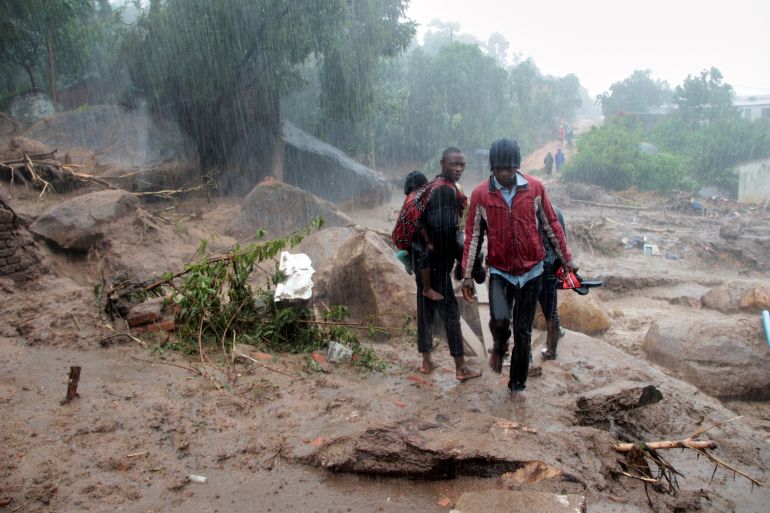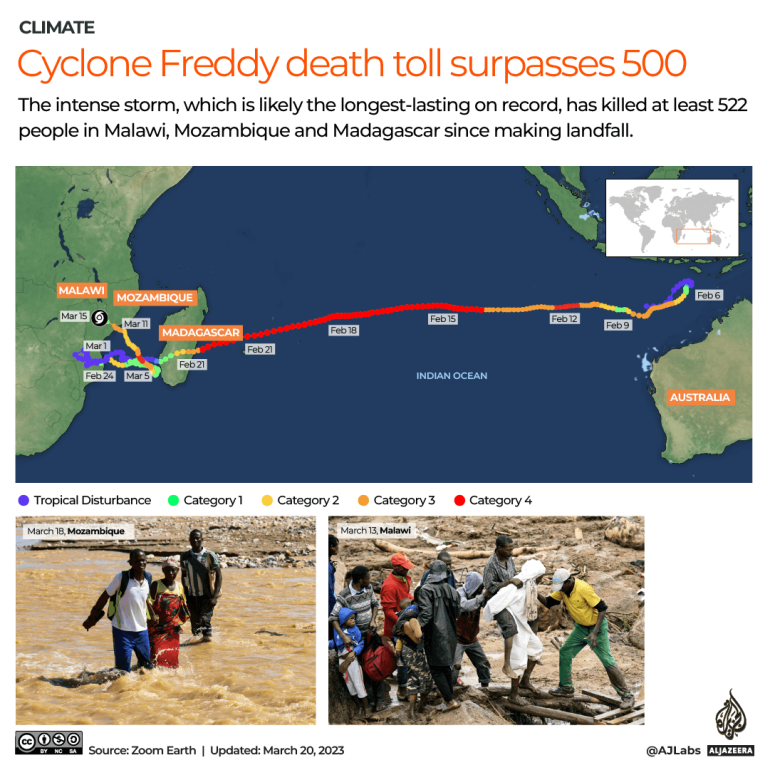Cyclone Freddy death toll in southeast Africa surpasses 500
The World Meteorological Organization says it is likely that Cyclone Freddy, which started in February, is the longest-ever in recorded history.

The death toll in southeast Africa due to the exceptionally long-lasting Tropical Cyclone Freddy has risen to 522, according to authorities in Malawi, Mozambique and Madagascar.
Disaster management authorities in Malawi, which has been hit the hardest by the cyclone, reported on Saturday that the death toll there had risen to 438. Malawi’s president, Lazarus Chakwera, declared a 14-day national mourning period on Thursday.
Keep reading
list of 3 itemsMalawi’s president appeals for immediate aid after Cyclone Freddy
Over 300 dead in Malawi, Mozambique as Cyclone Freddy losses pile
There are hundreds of evacuation centres set up across the country for survivors with tens of thousands in Malawi left homeless and approximately 345,000 people affected by the heavy rains, floods and landslides.

The cyclone left a trail of devastation in southeast Africa. Neighbouring Mozambique and the island nation of Madagascar have also been affected.
In Mozambique, at least 67 people died, according to President Filipe Nyusi, with 50,000 more displaced.
It is expected that the death toll in both nations will continue to climb. At least 17 people were killed in the island nation of Madagascar.
Cyclone Freddy dissipated over land late Wednesday after it made a second landfall in Mozambique and then Malawi over the weekend and caused mass devastation in several regions, including Malawi’s financial capital, Blantyre.
![Some of the Cyclone Freddy survivors at a camp in Blantyre, Malawi [Rabson Kondowe/Al Jazeera]](/wp-content/uploads/2023/03/Some-of-the-survivors-at-a-camp-in-Blantyre.-photo-by-Rabson.jpg?w=770&resize=770%2C578)
Reporting from Makanga, an island in Malawi, Al Jazeera’s Fahmida Miller said that while rescue services were continuing, they have been slow to transport people from flooded islands to the mainland.
“So far, they [the police services] have reached about 1,300 people, but hundreds more are waiting. They have had to seek refuge in trees. Their homes have been washed away and they also don’t have any food,” said Miller.
“It will certainly be at least a few more days before a bigger dent is made in terms of rescuing people in places like this, which have been very difficult to reach up until now,” she added.
Freddy first made landfall on February 21 in Madagascar. From there, the storm moved on to Mozambique and then back across the Indian Ocean. On March 11, it reached Mozambique for the second time and then moved on to Malawi.
“A lot of areas are inaccessible, restricting movement of assessment and humanitarian teams and life-saving supplies,” said Paul Turnbull, the World Food Program’s director in Malawi. “The true extent of the damage will only be revealed once assessments have been concluded.”
Both nations were already facing a cholera outbreak before the cyclone hit and there are fears that the flooding could worsen the spread of water-borne diseases. Mozambique was also dealing with Freddy’s first battering and floods earlier in the year.
Scientists say human-caused climate change has worsened cyclone activity, making them wetter, more intense and more frequent.
Cyclone Freddy has ravaged southern Africa since late February when it pummeled Mozambique, Madagascar and Réunion. It then looped back on to the mainland after regaining strength over the Mozambique Channel.
The World Meteorological Organization has convened an expert panel to determine whether Cyclone Freddy has broken the record for the longest-ever cyclone in recorded history.
Southern Africa is currently in cyclone season, which can bring rain and severe storms until March or April.